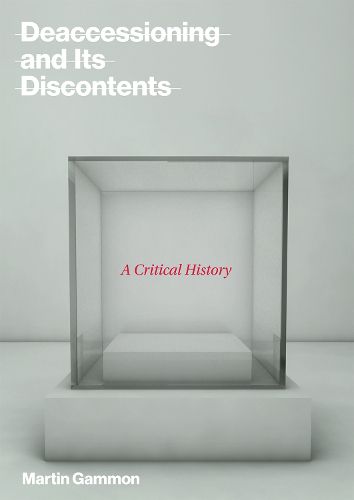Readings Newsletter
Become a Readings Member to make your shopping experience even easier.
Sign in or sign up for free!
You’re not far away from qualifying for FREE standard shipping within Australia
You’ve qualified for FREE standard shipping within Australia
The cart is loading…






The first history of the deaccession of objects from museum collections that defends deaccession as an essential component of museum practice.Museums often stir controversy when they deaccession works-formally remove objects from permanent collections-with some critics accusing them of betraying civic virtue and the public trust. In fact, Martin Gammon argues in Deaccessioning and Its Discontents, deaccession has been an essential component of the museum experiment for centuries. Gammon offers the first critical history of deaccessioning by museums from the seventeenth to the twenty-first century, and exposes the hyperbolic extremes of deaccession denial -the assumption that deaccession is always wrong-and deaccession apology -when museums justify deaccession by finding some fault in the object-as symptoms of the same misunderstanding of the role of deaccessions in proper museum practice. He chronicles a series of deaccession events in Britain and the United States that range from the disastrous to the beneficial, and proposes a typology of principles to guide future deaccessions.Gammon describes the liquidation of the British Royal Collections after Charles I’s execution-when masterworks were used as barter to pay the king’s unpaid bills-as establishing a precedent for future deaccessions. He recounts, among other episodes, U.S. Civil War veterans who tried to reclaim their severed limbs from museum displays; the 1972 Hoving affair, when the Metropolitan Museum of Art sold a number of works to pay for a Velazquez portrait; and Brandeis University’s decision (later reversed) to close its Rose Art Museum and sell its entire collection of contemporary art. An appendix provides the first extensive listing of notable deaccessions since the seventeenth century. Gammon ultimately argues that vibrant museums must evolve, embracing change, loss, and reinvention.
$9.00 standard shipping within Australia
FREE standard shipping within Australia for orders over $100.00
Express & International shipping calculated at checkout
Stock availability can be subject to change without notice. We recommend calling the shop or contacting our online team to check availability of low stock items. Please see our Shopping Online page for more details.
The first history of the deaccession of objects from museum collections that defends deaccession as an essential component of museum practice.Museums often stir controversy when they deaccession works-formally remove objects from permanent collections-with some critics accusing them of betraying civic virtue and the public trust. In fact, Martin Gammon argues in Deaccessioning and Its Discontents, deaccession has been an essential component of the museum experiment for centuries. Gammon offers the first critical history of deaccessioning by museums from the seventeenth to the twenty-first century, and exposes the hyperbolic extremes of deaccession denial -the assumption that deaccession is always wrong-and deaccession apology -when museums justify deaccession by finding some fault in the object-as symptoms of the same misunderstanding of the role of deaccessions in proper museum practice. He chronicles a series of deaccession events in Britain and the United States that range from the disastrous to the beneficial, and proposes a typology of principles to guide future deaccessions.Gammon describes the liquidation of the British Royal Collections after Charles I’s execution-when masterworks were used as barter to pay the king’s unpaid bills-as establishing a precedent for future deaccessions. He recounts, among other episodes, U.S. Civil War veterans who tried to reclaim their severed limbs from museum displays; the 1972 Hoving affair, when the Metropolitan Museum of Art sold a number of works to pay for a Velazquez portrait; and Brandeis University’s decision (later reversed) to close its Rose Art Museum and sell its entire collection of contemporary art. An appendix provides the first extensive listing of notable deaccessions since the seventeenth century. Gammon ultimately argues that vibrant museums must evolve, embracing change, loss, and reinvention.